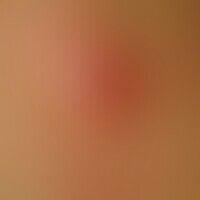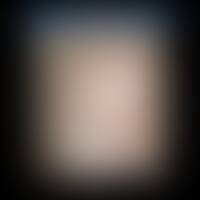
Primary cutaneous B-cell lymphomas C82- C83
Lymphoma, cutaneous B-cell lymphoma. Chronically active, continuously increasing clinical picture, existing for 6 months. red, blurred, solid, not painful, non-scaling nodular agglomerate consisting of several individual nodes, located on the lateral thorax, with a bumpy surface.

Myiasis (overview) B87.9
Furunculoid myiasisMyiasis: After a stay in the tropics the 25-year-old patient showed a furunculoid nodule with central porus on the left thigh which was only slightly (!) painful.

Psoriasis erythema anulare centrifugum-like L40.8
Psoriasis Erythema anulare centrifugum-like: relapsing-active plaque psoriasis with disseminated, anular lesions

Lupus erythematosus systemic M32.9
Systemic lupus erythematosus: acute maculopapular exanthema, accompanied by recurrent fever attacks, fatigue and tiredness, arthralgia, inflammation parameters +, ANA high titer positive, rheumatoid factor +, DNA-AK+.

Schnitzler syndrome L53.86
Schnitzler syndrome: considerable feeling of illness with recurrent fever attacks, itchy urticarial (here rather discreetly developed) exanthema (exanthema attacks go parallel with the periodic fever); furthermore exhaustion and tiredness.

Contact dermatitis allergic L23.0
Contact dermatitis allergic: multiple, acute, continuously progressive for 4 weeks, large, isolated and confluent, blurred (scattered edges), severely itching, red, rough, scaly, weeping plaques. polymorphism by papules, erosions, vesicles.

Psoriasis (Übersicht) L40.-
Psoriasis guttata. 0.1-2.0 cm in size, reddish, rough papules and plaques with fine-lamellar scaling on the trunk and extremities in a 24-year-old woman, acutely and de novo. This was preceded by a feverish streptococcal angina. After the first manifestations had healed, the psoriasis then developed into a chronic, intermittent course over many years.

Zoster B02.9
Zoster: disseminated, grouped vesicles and pustules on reddened skin in a 38-year-old man; course along the segment Th.3.

Scabies nodosa B86.x

Candle syndrome E88.1
CANDLE syndrome: recurrent multiform exanthema with anular (circle) and erythema muldtiforme-like erythema/plaques (marked by square)

Lichen planus exanthematicus L43.81
Lichen planus exanthematicus. symmetricgeneralized distribution pattern of Lichen planus. the densification of the efflorescences in the belt region is to be interpreted as (pressure-induced) Koebner phenomenon.

Symmetrical drug related intertriginous and flexural exanthema L24.4; L25.1
SDRIFE: large, acute urticarial plaques with blurred edges, with a certain probability caused by the ingestion of a taxane cytostatic drug.












